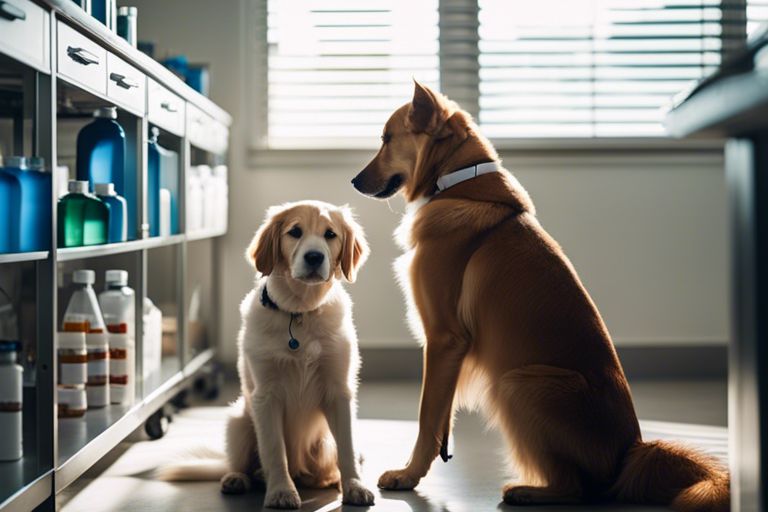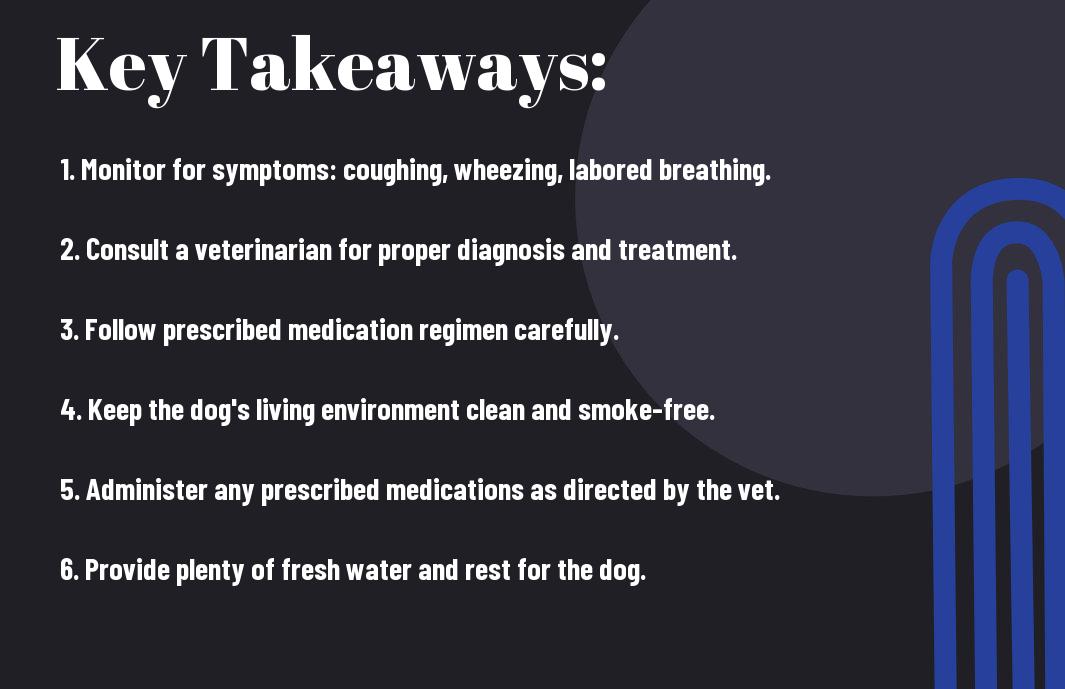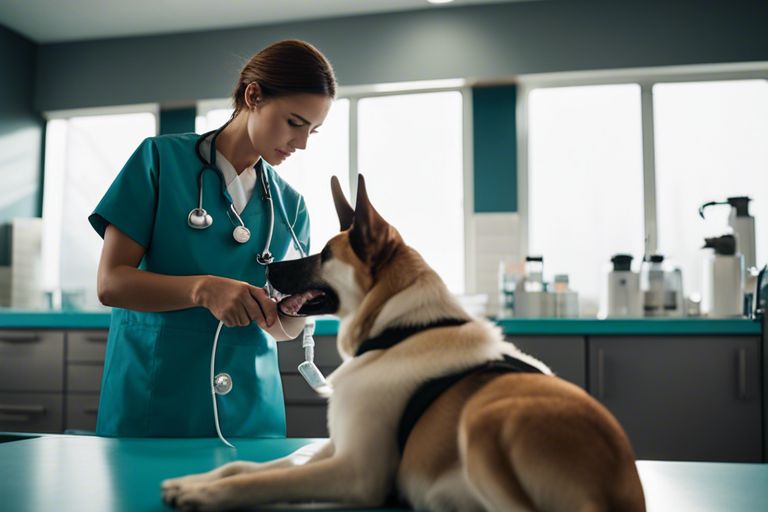Just like humans, dogs can also experience respiratory problems that may require prompt treatment. Identifying the signs early and taking appropriate action can help alleviate your furry friend’s discomfort and prevent any potential complications. In this article, you will learn about common respiratory issues in dogs, their symptoms, and the various treatment options available to help your pup breathe easier.
Key Takeaways:
- Determine the underlying cause: Proper diagnosis is crucial for treating respiratory problems in dogs effectively. Identifying the root cause, whether it’s an infection, allergies, or structural issues, will guide the treatment plan.
- Medication and therapy: Depending on the diagnosis, your veterinarian may prescribe antibiotics for infections, steroids for inflammation, or bronchodilators to help with breathing difficulties. Nebulization therapy can also be used to deliver medication directly to the lungs.
- Surgical intervention: In severe cases, surgery may be necessary to correct structural abnormalities like collapsing trachea or remove tumors obstructing the airways. Surgical options should be discussed with your veterinarian to determine the best course of action.
Identifying Respiratory Problems in Dogs
The first step in addressing respiratory problems in dogs is to identify the symptoms that may indicate an issue. It’s vital to pay attention to any changes in your dog’s breathing patterns or behavior that could signal a respiratory problem.
Common Symptoms
Identifying common symptoms of respiratory problems in dogs includes observing coughing, wheezing, difficulty breathing, and nasal discharge. Additionally, keep an eye out for signs of fatigue, lack of appetite, and blue-tinged gums, which can signify a lack of oxygen in the bloodstream. If you notice any of these symptoms, it’s crucial to consult your veterinarian for a thorough examination and diagnosis.
Breeds Prone to Respiratory Issues
Any dog can develop respiratory problems, but some breeds are more prone to issues due to their anatomy. Brachycephalic breeds, such as Bulldogs, Pugs, and Boston Terriers, are known to have respiratory challenges because of their short snouts and flat faces. These breeds may experience difficulties breathing, especially in hot or humid weather, and may require special care to manage their respiratory health.
Symptoms in breeds prone to respiratory issues may manifest as noisy breathing, exercise intolerance, and an increased risk of heat stroke. It’s crucial to be aware of these breed-specific concerns and work closely with your veterinarian to develop a proactive care plan to support your dog’s respiratory health.
Causes of Respiratory Problems in Dogs
Some respiratory problems in dogs can be attributed to various factors, including genetic, environmental, infections, and allergies. Understanding the underlying causes can help you identify and address the issue effectively.
Genetic Factors
To probe into genetic factors, some dog breeds are predisposed to respiratory issues due to their anatomy. Breeds like pugs, bulldogs, and Boston terriers have brachycephalic skulls with narrow airways, making them more prone to respiratory difficulties. Other genetic conditions, such as collapsing trachea or laryngeal paralysis, can also contribute to respiratory problems in certain breeds. Recognizing these breed-specific traits can guide you in providing appropriate care and monitoring for any signs of respiratory distress.
Environmental Factors
An important aspect of environmental factors is the impact of secondhand smoke on dogs. Your furry companion inhales the same harmful toxins as you when exposed to cigarette smoke, which can irritate their respiratory system. Though it may seem harmless, your smoking habit can significantly affect your dog’s respiratory health. Thou should create a smoke-free environment to protect your pet from unnecessary respiratory issues.
Additionally, outdoor pollutants like pollen, dust, and mold can trigger respiratory problems in dogs, especially those with allergies. This can lead to symptoms such as coughing, wheezing, and difficulty breathing. Regularly cleaning your home and creating a safe, allergen-free space for your dog can help minimize respiratory issues. Thou should also monitor your dog’s outdoor activities during high pollen seasons to prevent exposure to allergens.
Infections and Allergies
Environmental factors such as exposure to infectious agents like viruses and bacteria can also lead to respiratory problems in dogs. This can result in conditions like kennel cough or pneumonia, which require prompt veterinary attention. Additionally, dogs can develop allergies to pollen, dust mites, or certain foods, causing respiratory symptoms like sneezing and nasal discharge. This can impact your dog’s quality of life and overall health.
This emphasizes the importance of identifying and addressing the underlying causes of respiratory problems in dogs. By understanding the various factors that can contribute to these issues, you can take proactive steps to prevent and manage respiratory problems in your beloved pet.
Diagnosis and Testing
Unlike Respiratory Infection In Dogs: Symptoms & Management, where the focus is on managing the symptoms, diagnosing respiratory problems in dogs requires a thorough examination and testing. Your veterinarian will start with a physical examination to assess your dog’s overall health and gather important clues about the respiratory issue at hand.
Physical Examination
With the physical examination, your veterinarian will listen to your dog’s lungs and heart, check for any signs of nasal discharge, coughing, or abnormal breathing sounds. They may also examine your dog’s mouth and throat for any obstructions or abnormalities that could be causing respiratory distress. This initial assessment helps in determining the next steps for a more accurate diagnosis.
Laboratory Tests
Diagnosis of respiratory problems in dogs often involves laboratory tests for a more in-depth analysis. For instance, blood tests can help identify the presence of infection or inflammation in the body. Additionally, a complete blood count (CBC) can provide information about your dog’s immune response and overall health status, which can be crucial in understanding the underlying cause of the respiratory issue.
Imaging Studies
Physical imaging studies such as X-rays or ultrasound may be recommended to visualize the internal structures of your dog’s respiratory system. This can help identify any abnormalities, such as tumors, infections, or foreign objects, that may be affecting your dog’s breathing. The results from these imaging studies can provide valuable information to assist in formulating an accurate diagnosis and treatment plan.
The imaging studies play a vital role in diagnosing respiratory problems in dogs by providing a clear picture of what might be causing the issue. The information gathered from these studies can guide your veterinarian in determining the most effective treatment approach for your furry companion.
Treatment Options for Respiratory Problems
Medications
For respiratory problems in dogs, medications play a crucial role in the treatment plan. Your vet may prescribe antibiotics to treat bacterial infections or bronchodilators to help open up the airways and make breathing easier for your furry friend. It’s imperative to follow your vet’s dosage instructions carefully and complete the full course of medication to ensure the best outcome for your dog.
Oxygen Therapy
Options for oxygen therapy may be recommended by your vet for more severe respiratory issues in dogs. Oxygen therapy can help improve oxygen delivery to your dog’s tissues and organs when they are not getting enough through regular breathing. This treatment can be administered in various ways, such as through a mask, oxygen cage, or nasal prongs, depending on your dog’s specific needs.
Treatment with oxygen therapy can help alleviate respiratory distress and support your dog’s recovery by providing supplemental oxygen directly into their lungs. This method is often used in emergency situations or for dogs with chronic respiratory conditions that require ongoing support to maintain proper oxygen levels in the body.
Surgery
For respiratory problems that cannot be managed effectively with medications or other conservative treatments, surgery may be considered as a treatment option. Surgical procedures such as removing airway obstructions, repairing anatomical abnormalities, or addressing certain tumors can help improve your dog’s respiratory function and overall quality of life.
Consult with your vet to determine if surgical intervention is the best course of action for your dog’s respiratory issues. They will evaluate your dog’s condition and provide recommendations on the most suitable surgical approach to address the underlying respiratory problem effectively.
Managing Respiratory Problems at Home
Creating a Comfortable Environment
Your dog’s comfort is crucial when managing respiratory problems at home. One way to help is by ensuring a calm and quiet environment. Provide a soft bed or cushion in a warm area with good airflow. Keep the space free of irritants such as smoke, strong odors, or dusty surfaces to support your dog’s breathing.
Providing Nutritional Support
On top of creating a comfortable environment, providing proper nutrition is vital. Ensure your dog has access to fresh water at all times, as hydration plays a critical role in maintaining respiratory health. Additionally, consider feeding your dog high-quality, easily digestible food to support their overall well-being.
Offering small, frequent meals can also help prevent your dog from overeating, which can put extra strain on their respiratory system. Consult your veterinarian for recommendations on the best diet for your dog’s specific respiratory condition.
Managing Administering Medication
Managing medications correctly is crucial in treating respiratory problems in dogs at home. Follow your veterinarian’s instructions carefully when administering any prescribed medications. Whether it’s antibiotics, bronchodilators, or anti-inflammatory drugs, consistency in dosing is key to helping your furry friend feel better.
It’s vital to keep track of your dog’s medication schedule and not to skip any doses. If you have any concerns or notice side effects, contact your vet immediately for guidance on how to proceed.
Preventing Respiratory Problems in Dogs
Vaccinations and Preventatives
After consulting with your veterinarian, it is vital to ensure your dog receives all necessary vaccinations to prevent respiratory infections. Vaccines protect your dog from common viruses such as canine influenza and Bordetella, which can lead to respiratory issues if left unaddressed. Additionally, using preventatives like flea and tick medications can help prevent allergic reactions that may exacerbate respiratory problems in your dog.
Regular Exercise and Activity
Problems can arise when dogs are sedentary and not engaging in regular exercise. Regular physical activity helps to keep your dog’s respiratory system healthy and can reduce the risk of developing respiratory issues. Aim for daily walks, play sessions, or other forms of exercise to keep your dog’s lungs functioning well and their overall health in check.
Understanding your dog’s breed and age is crucial when planning their exercise routine. Different breeds have varying exercise needs, and elderly dogs may require shorter, gentler activities to prevent overexertion that could strain their respiratory system.
Reducing Stress
Regular exercise and mental stimulation are key in reducing stress levels in your dog. Dogs that are stressed may exhibit rapid breathing or panting, which can exacerbate existing respiratory issues. Providing a stable and secure environment, routine playtime, and positive reinforcement training can all contribute to reducing stress and promoting overall respiratory health in your dog.
Plus, ensure your dog has a comfortable and quiet place to rest, away from loud noises and other stress triggers. Adequate rest and relaxation are vital for a healthy respiratory system in your furry friend.
Summing up
With these considerations in mind, treating respiratory problems in dogs requires prompt attention and careful observation of symptoms. From identifying potential causes to seeking veterinary advice and potentially using medications or therapies, it’s crucial to prioritize your furry friend’s respiratory health. Keep in mind, early detection and proper treatment can lead to improved outcomes and a better quality of life for your canine companion.
FAQ
Q: What are common respiratory problems in dogs?
A: Common respiratory problems in dogs include kennel cough, pneumonia, asthma, bronchitis, and collapsing trachea.
Q: What are the symptoms of respiratory problems in dogs?
A: Symptoms of respiratory problems in dogs may include coughing, wheezing, shortness of breath, nasal discharge, rapid breathing, lethargy, and cyanosis (blue tint to the gums).
Q: How are respiratory problems in dogs diagnosed?
A: Respiratory problems in dogs are diagnosed through a physical examination, x-rays, blood tests, and possibly a bronchoscopy or tracheal wash to collect samples for analysis.
Q: How are respiratory problems in dogs treated?
A: Treatment for respiratory problems in dogs may include medications such as antibiotics, bronchodilators, cough suppressants, and steroids, as well as oxygen therapy and supportive care.
Q: How can respiratory problems in dogs be prevented?
A: To help prevent respiratory problems in dogs, ensure they are up to date on vaccinations, maintain a healthy weight, avoid exposure to smoke and pollutants, provide regular exercise, and keep their environment clean and free of allergens.
Are strawberries toxic for dogs
Your Dog’s Allergies: Expert Advice
Demystifying Anal Gland Issues in Dogs: Your Comprehensive Guide from the American Kennel Club




